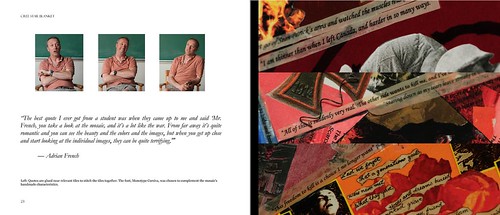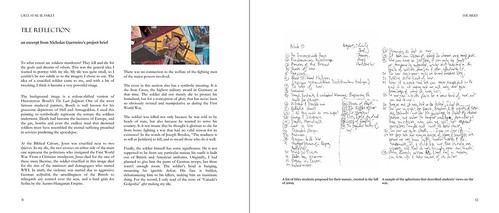At about 3 AM on July 2nd, I finished writing my first book. Well, that’s not technically true. I’ve been fiddling with minor layout issues and finding spelling errors since then, so I guess I’m not done until I send it off to the printer, but the heavy lifting was finished then. This author title doesn’t seem to fit me, though. I guess that’s what happens when you fall into stuff. See, it wasn’t even my idea. It was yet another blasted high school Social Studies project to be vanquished. It was a last hurrah, a chance to finally get high school out of my system and be comfortable with the fact that I am a second year university student. Yeah, like that was going to happen.
For those not “in the know”, I was contacted late last year by one of the great high school teachers of my life, Adrian French, who asked me to take on a project about a project, specifically to document one school project and the place that the novel Three Day Road by Joseph Boyden had in it. The actual school project is a spectacular thing, a multi-disciplinary one that incorporates student poetry inspired by the novel, the hard facts of World War One, and an enormous mosaic that serves as a way to visualize the emotions of the war as seen through the eyes of a 17-year-old high schooler, among other things.

It was French’s idea to make the book as a sort of “thank you” for Mr. Boyden. It had been kicking around in his head for a few years, and there were some attempts to get it off the ground, but to no avail. When I was approached to lead the charge, I said yes, even though I expected to be dragged through some mud for a while. After the initial excitement, I did what every good Challenge student did, and put it off. There was no firm deadline on this, so I sort of kept it in the back of my mind. I knew I wanted to do a photo-driven coffee table book right away. I just didn’t know where to go from there.
On April 19th, after I finished my last exam of my first year of university, I decided to put in the time to get this project off the ground. Some eager high schoolers, two years my junior, were tasked with helping me in this endeavor around Spring Break, but on that Thursday night, things really started to cook. That night, Celina Chan assembled a crew of overly-enthusiastic and highly intelligent Grade 11 students, and the conversation got started. For three glorious hours, a rapid fire dialogue occurred between myself and the 15-or-so members of the group. We discussed layout ideas, fonts, content to include, and everything else under the sun. That was the push I needed to get my lazy ass off the couch (the fifth season of Mad Men was in full swing, after all) and to actually do the work.
Like the war that the project chronicled, there were a few major pushes interspersed with some sitting around. In the last few weeks of June, I had realized I had spent half my summer vacation doing this, and so I redoubled my efforts to get it done so it would not consume all of it. Those last two days of June were very chaotic. I applaud those team members who answered my last minute cries for help quickly and calmly. Now that the book is finished, I’m fairly safe in assuming that no high school social studies project has ever been documented for history as painstakingly as this one. I hope this doesn’t start a precedent. I wouldn’t wish this on anyone (kidding!).
Part of the reason it took so long was because, frankly, I am not a very good writer. I sort of imagine my writing process like a manual meat grinder working through some particularly bad cut of beef. The end product should be similar in consistency to the ground beef from some big, efficient, automated meat grinder; it just took a little too much sweat to get there.

This was absolutely a labor of love. There was frustration, to be sure, but it was mostly with the Blurb-provided software. In an earlier blog post, I had mentioned the Lightroom book module, and while the templates were excellent, the inability to modify them was a dealbreaker. There are many sophisticated customization options that are available in the LR Book module, like tracking and kerning adjustment, but the inability to modify even the simplest layouts or add a text box sort of killed it for me. I guess it is meant for picture books, then, which makes sense. I guess it’s my fault for not learning InDesign earlier. I’ve never been much of a graphic designer either.

Throughout the writing process, I was very impressed with the output of these 17 year olds. After all, I had to sort through their old homework. Yes, they are still 17, and their youth does show through, but they really did think things through before putting them down on paper. Their feelings are real, and I don’t think they would have felt anything at all had Three Day Road not forced students to connect emotionally with two young soldiers (however fictional they may have been) and give them a picture of the war that doesn’t consist of a timeline with the key events and dates. It was a deafening, muddy conflict that did not treat people as people, but rather as another expendable tool of war. Reading about soldiers using broken bodies as something to reinforce the trenches with was affecting, and while it would have raised an eyebrow in a textbook, the true impact would have been lost because I wouldn’t have known that was a person with a name that I sympathized with earlier in the book. It made all the difference. I did the project once, and referred back to it numerous times throughout the writing process. It sure didn’t seem like much when I was writing it, but hindsight is always 20/20.
I tried to make the book as self-contained as possible (always a good thing), so it covers the development of the Cree Star Blanket project right up to the recognition it received in November 2010 from the Governor General of Canada. Being a photographer, I came up with the photos in my head first. I enjoyed shooting those divider photos immensely. Maybe it was because I had willing subjects. I don’t always get those.

For followers of Joe McNally, it is easy to see where I got some of my ideas from. His photos and his philosophy, particularly for The Moment it Clicks, served as the inspiration for the look and feel of the photos in my book. One foot on the coffee table and one foot in the classroom is how I envisioned it from the very beginning, only I didn’t set out to teach anyone anything. That just happened to be the setting for the photos.
I’ve always admired his ability to produce good work no matter what situation he’s dropped into, and it’s a quality that I hope to have someday. Unlike Joe (who will never live down the infamous SB-800 tree from Dubai), I had only the simplest of light setups at my disposal (one 60” umbrella and one SB-600), and I used it for every formal portrait in the book. Add a pale gold gel, my camera body, and a 35mm f/1.8 DX lens, and that was essentially it. I wanted to add some color to the book, and I couldn’t think of a better way to do it than to reveal the faces of those who did the project. The light isn’t complicated, nor should it have been.
If you’re interested in purchasing a copy for yourself to see what the fuss is all about, I’m working on it. I might put it on sale in the Blurb bookstore, or I might do something else. I’ll post about it when I figure things out. I think I’m to discuss this with Adrian over dinner this week. I think it will be the best steak I will ever have in my life.
UPDATE (11/06/2012): The book is now available for purchase as a PDF, a softcover, or as a hard cover book with dust jacket (which was how the book was intended to be read). To order a copy and to support this project, please click here.
NEW: Preview the first 15 pages of the book below. Click the full screen button for best results.




